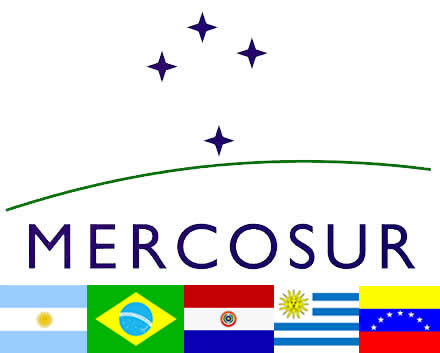MERCOSUR
ON MARCH 26, 1991, the presidents of ARGENTINA, BRAZIL, PARAGUAY, and URUGUAY signed a common market agreement, the Treaty of Asuncion, that set the basis for the creation of the Common Market of South America (MERCOSUR, or Mercado Comun del Sur). MERCOSUR was the final step in a long struggle for economic and political cooperation in the region. The common market agreement has its origins in a previous agreement between Argentina and Brazil. The two most powerful countries in South America had signed in 1986 an agreement of economic and political cooperation known as the Argentine-Brazilian Economic Integration Program (ABEIP). The MERCOSUR agreement called for the creation of a free trade zone and the full integration of the regional economies. Argentina and Brazil joined the common market in December 1994, and Paraguay and Uruguay a year later. Its most important dispositions included a progressive reduction of trade tariffs and the establishment of common external tariffs. The four countries also agreed on coordinating their macroeconomic policies. According to the treaty, trade tariffs would be progressively reduced. By 2000, as Jeffrey Cason explains, “their custom union has made duty-free in approximately 90 percent of all goods, and the four core member nations have agreed to a common external tariff on nearly all goods.”

MERCOSUR responded to both political and economic motivations. From a political perspective, it was an effort to guarantee regional political stability and consolidate democratic institutions. In a presidential summit in 1992, the four countries agreed that “an indispensable assumption for the existence and development of MERCOSUR is that democratic institutions are in force,” Peter Smith exlains. This compromise was reinforced in 1998 in a meeting in Usuahia, Argentina, where the four MERCOSUR countries and two new associated members (CHILE and BOLIVIA) agreed on the compromise to defend democracy and maintain peace in the region.
From an economic perspective, MERCOSUR brought together the most important and stronger economies of South America in an effort for economic integration and liberalization of international trade. Brazil, however, has always played the leading and stronger role. MERCOSUR had an immediate impact on regional trade. Between 1990 and 1996, internal trade increased from $4.1 billion to $17.0 billion, according to Smith. MERCOSUR has also maintained discussions with the EUROPEAN UNION to create a free trade agreement.
Although MERCOSUR has been an important agent since the mid-1990s, it has also suffered from institutional limitations and faced strong barriers. The creation of a common market and a common custom system has been imperfect, and by 2000 there were still some conflicts and disputes with tariffs. In addition, the internal contradictions of the regional economies have limited the benefits and growth of a common market. The most visible contradictions have been the social and economic structures. During the 1990s, while this subregion concentrated about 200 million people, about 20 percent lived in poverty.